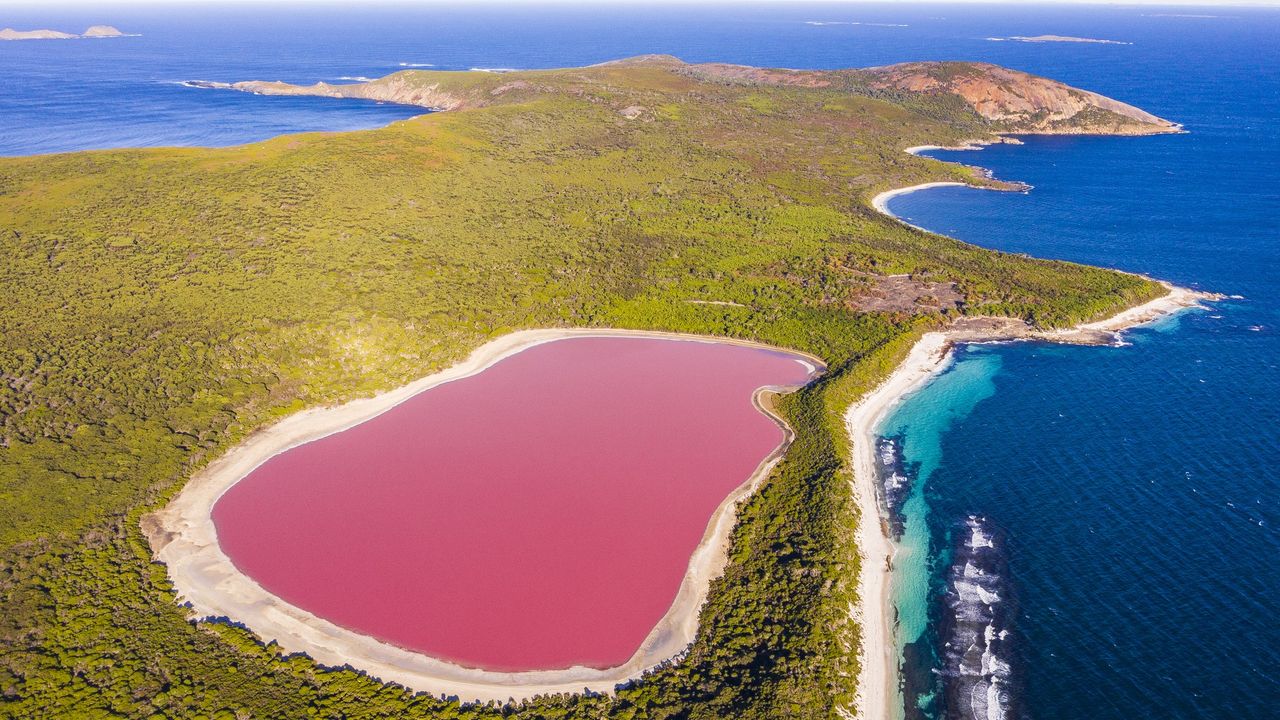
QUICK FACTS
Name: Lake Hillier, Pink Lake and others
Location: Western Australia
Coordinates: -34.09487137998776, 123.20277096721424
Why it’s incredible: Bacteria and microalgae turn these lakes bubblegum-pink.
Australia’s pink lakes are bodies of water that harbor rare, pigment-producing microbes. The lakes are about 10 times saltier than the ocean, attracting algae and bacteria that churn out beta-carotene — a red-orange pigment that also gives carrots, crayfish and flamingos their characteristic colors.
Most of the country’s pink lakes are found in Western Australia, which has around a dozen. The lakes are the remnants of rivers that flowed across the landscape more than 15 million years ago, which makes them thousands of years old, according to National Geographic.
As the ancient rivers dried up, pockets of water were left over and partially evaporated over time, concentrating salt and attracting salt-loving microorganisms such as Dunaliella salina and Salinibacter ruber — which are single-celled algae and red bacteria, respectively. D. salina and S. ruber produce beta-carotene when exposed to sunlight, turning the lakes different shades of pink depending on salt levels. Beta-carotene protects these microorganisms from ultraviolet rays and absorbs light energy, enabling them to thrive and reproduce, according to National Geographic.
But pink lakes are fragile because changes in salinity can upset their regular inhabitants. Heavy rainfall, for example, can dilute the lakes’ salt content to the extent that photosynthetic algae completely replace D. salina and S. ruber.
This recently happened at Lake Hillier on Western Australia’s Middle Island, according to ABC News. Lake Hillier previously harbored a wide array of pigment-producing microbes, but extreme rainfall due to climate change in 2022 disturbed this community. As a result, the lake turned from pink to blue-gray — but experts think it could recover within the next 10 years if salinity returns to its previous levels.
Related: Lake Natron: The caustic, blood-red lake in Tanzania that turns animals to ‘stone’
Lake Hillier is not the only pink lake to have lost its rosy tint. Pink Lake, situated near Esperance in Western Australia, turned blue-gray in the 2000s after a century of salt mining. Salt was extracted to make table salt, salt licks for livestock, and preservatives for meat and hides, according to National Geographic. By the early 2000s, there was not enough salt left in Pink Lake for species like D. salina and S. ruber to survive. As photosynthetic algae took over, the change in color was so dramatic that locals lobbied for the lake to be renamed.
Unlike Lake Hillier, experts don’t think that Pink Lake will recover naturally any time soon — but scientists have suggested artificially pumping salt from nearby salt lakes into Pink Lake to return it to pre-mining levels.
Pink lakes are feeding grounds for nomadic and migratory birds, and they host invertebrates like brine shrimp and salt lake snails, which makes them valuable ecosystems. Extreme environments like pink lakes also help scientists to understand the potential for life on Mars.
“They still produce some of the toughest organisms on the planet,” Angus Lawrie, a conservation biologist and research associate at Curtin University in Australia, told National Geographic.
Discover more incredible places, where we highlight the fantastic history and science behind some of the most dramatic landscapes on Earth.


1 Comment
fkpupn